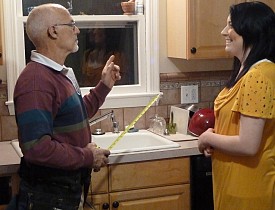A Guide to Contractor Jargon
 Sit down with a group of building industry professionals, and in short order you’ll start to hear “shop talk” that makes you snicker or has your eyes glazing over. Here’s a short list of jargon used by general contractors. Throw a few of these construction terms around and you can fool anyone into thinking you’re savvier than the average Joe when it comes to home improvement.
Sit down with a group of building industry professionals, and in short order you’ll start to hear “shop talk” that makes you snicker or has your eyes glazing over. Here’s a short list of jargon used by general contractors. Throw a few of these construction terms around and you can fool anyone into thinking you’re savvier than the average Joe when it comes to home improvement.
BUILDING JARGON
Mud: Not the stuff tracked into the house during inclement weather, this refers to any type of plaster, spackle, stucco, concrete or other semi-liquid material used to coat walls, ceilings, foundations and similar surfaces.
Butt Joint/Corner Bead: When two sheets of drywall/sheetrock are butted together, the joint between them is called a butt joint. These are taped and plastered. The corner bead is most often a metal piece nailed or crimped to the outside corners of a sheetrocked wall. After “mud” is applied, it forms a smooth, durable corner.
Slump: This is what homeowners tend to do when they review a project bid, but it’s also the term to describe concrete mix consistency. A “slump test” will determine the consistency between batches and the concrete’s workability, and is especially important in foundation work. Slump is tested by pouring concrete in a metal container and letting it sit for a period, then assessing the distance it drops – the greater the distance, the higher (wetter) the slump.
Rebar/Stirrups: Rebar are straight steel rods used as footings and beams in foundation work, providing additional reinforcement and adding to mechanical strength in concrete. The stirrups are rebar pieces that are bent and tied to rebar to form a specific shape, such as a rectangle.
Stud: Don’t get excited, ladies! In the building industry a stud refers to a vertical structural member and not a handsome contractor. Studs can be made of either wood or metal and in wall construction, will be attached to two top plates and one bottom plate. The longer the stud, the higher the ceiling height, but spacing between studs is usually on 16 or 24 inch centers.
Top Plate/Bottom Plate: The top plate is the horizontal member on the top section of a wall, and there are usually two, while the bottom plate is the bottom board, commonly a 2x4 or 2x6 depending on wall thickness.
Header/Footer: Headers are structural members running perpendicular to floor and ceiling joists, which are used to create an opening. Conversely, a footer is the bottom part of a foundation. Footings help distribute the weight of the structure, preventing movement and minimizing settling.
Truss: While you truss the turkey on Thanksgiving, your contractor uses trusses to support the roof of your home. Trusses are prefabricated, triangular wood structures, commonly customized to architectural specifications.
Valley: As its geographical definition implies, a valley is the lowest point in a roof where rafters of different angles meet. It’s also one of the most susceptible areas for roof leaks if not properly protected with a waterproof membrane and appropriate flashing.
Fascia: In anatomy, fascia refers to the connective tissue binding together muscles and organs in the body. In building, it refers to the vertical board that covers the horizontal soffit/eaves on a home.
ELECTRICAL JARGON
Gang Box: Typically made of metal or PVC plastic, these boxes hold outlets and switches flush with the wall. Depending on how many switches or outlets are needed, they most commonly come in single, double or triple sizes.
Breaker: Having nothing to do with dancing, a breaker is an electrical safety device that protects circuits from overloading. If the amount of electrical current exceeds the amperage the circuit can handle, the breaker will be tripped and need resetting.
Home Run: Here's a phrase stolen from the game of baseball. Electricians use this construction term to identify the main line which runs from your electric service panel to the first device in your home’s electrical circuit.
Pig Tail: This is an old-time description of a temporary electrical light. Contractors often connect a bare-bones light socket to a primary electrical wire if permanent lighting is not yet installed or has been removed during a remodel.
PAINTING JARGON
Chalking: Minus the blackboard, chalking is the powdery substance that indicates deterioration on the surface of exterior paint after severe weathering. This must be removed before repainting can occur.
Alligatoring: When paint is unable to bond to a glossy surface, a cracked and scaly pattern will result. This often occurs in instances where the surface was not properly prepared for recoating. It's more common in older homes.
Cutting In: This is outlining done around ceilings, baseboards, doorways and windows before a painter can start rolling the surface of a wall. An angled or “cutting” brush is used to applying a sharp, clean paint line.
Boxing: When working on a large area that requires several cans of paint, your painting contractor will “box,” or mix together, the contents of the different cans to ensure consistency of color.
TRIVIA DEFINITION
Astragal: Got a pair of French doors? An astragal refers to the prominent raised overlap where the two doors meet (known as the "meeting stiles"), that closes the clearance gap between doors. Test your contractor’s level of knowledge by asking him what an astragal is!
Laura Foster-Bobroff writes for Networx.com.
Updated April 4, 2018.
Looking for a Pro? Call us (866) 441-6648

Electrical Average Costs
Electricians Experiences

Major Bathroom Restoration After Flooding From A Burst Pipe

Beware Of Bad Contractors! Take My Advice To Protect Yourself



